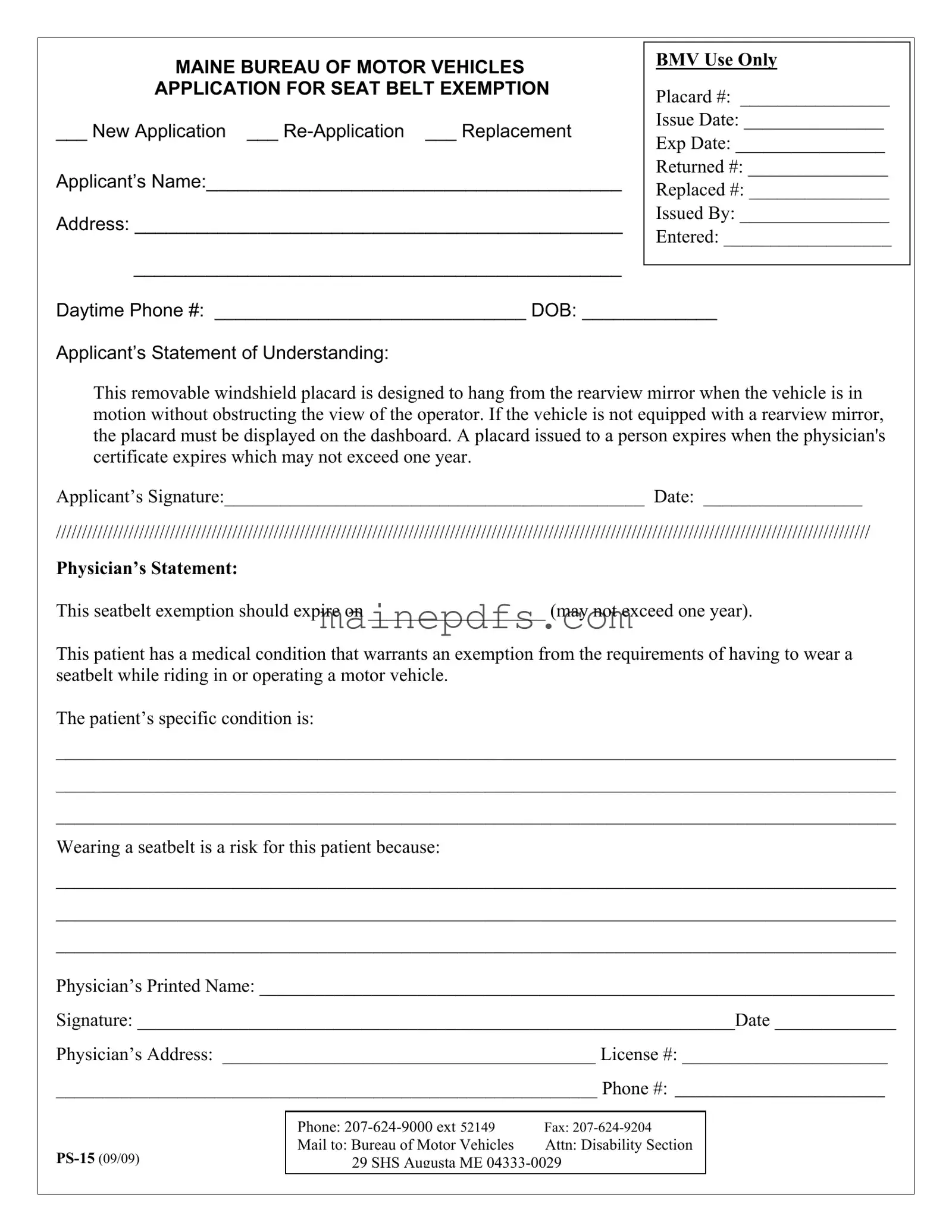The PS-15 Maine form, specifically designed for seat belt exemption due to medical conditions, shares similarities with other specialized forms and applications that cater to individuals with unique needs or circumstances. Each of these documents plays a crucial role in ensuring that these individuals receive the accommodations necessary for their health and safety while remaining compliant with state laws and regulations.
Similar to the PS-15 Maine form, the Disabled Parking Placard Application in many states provides individuals with disabilities the means to apply for a parking permit that allows them to park in designated accessible parking spaces. This form typically requires personal information, a physician’s certification, and details about the nature of the disability, paralleling the PS-15's requirement for a physician's statement to support the applicant's need for a seat belt exemption.
The Medical Waiver Application for window tinting exemption is another document bearing resemblance to the PS-15 form. Certain health conditions necessitate protection from sunlight, prompting individuals to request permission for darker window tints than the law usually allows. Just like the seat belt exemption form, it requires a physician’s certification detailing why the exemption is medically necessary for the patient's health.
An Application for Exemption from Vaccinations for medical reasons also echoes the structure and purpose of the PS-15 form. In situations where an individual has a medical condition that contraindicates vaccinations, this form, supported by a physician’s detailed explanation, grants an exemption. It underlines the need for an authoritative medical endorsement, similar to the seat belt exemption.
The Doctor’s Certification for Medical Disability Benefits form is used when individuals apply for disability benefits or need to verify their condition for employers or other entities. It requires detailed medical information and a physician’s signature, akin to the PS-15 form’s need for a medical professional’s assessment and approval.
License Renewal for Elderly Drivers, in some jurisdictions, necessitates a physician’s evaluation to ensure the driver remains capable of safely operating a vehicle. This process often involves a form where a medical professional must detail the driver's physical and cognitive abilities, drawing parallels to the PS-15's reliance on a physician’s declaration of a medical condition justifying an exemption.
Medical Cannabis Registration forms, required in states where medical cannabis is legal, also share similarities with the PS-15 form. Applicants must provide proof of a qualifying medical condition through a physician’s certification, emphasizing the medical community’s role in verifying the necessity for an exception to standard regulations.
The Application for Food Allergy Exemption in schools allows parents to request special dietary accommodations for their children with severe food allergies. This form often requires a physician’s statement detailing the allergy and the necessary measures to avoid exposure, highlighting the importance of medical documentation for safety exemptions, similar to the PS-15 form.
Another comparable document is the Request for Air Travel Oxygen Accommodation. Travelers with certain medical conditions may need supplemental oxygen during flights, and this request form requires detailed medical information and physician approval, paralleling the physician's supporting statement on the PS-15 form.
Lastly, the Emotional Support Animal (ESA) Registration form, which allows individuals with mental health conditions to have their pets with them in housing or on flights, requires a mental health professional’s letter detailing the necessity of the ESA for the individual's mental health. This documentation process reflects the PS-15 form’s requirement for a health professional’s certification to obtain a necessary exemption based on medical grounds.

